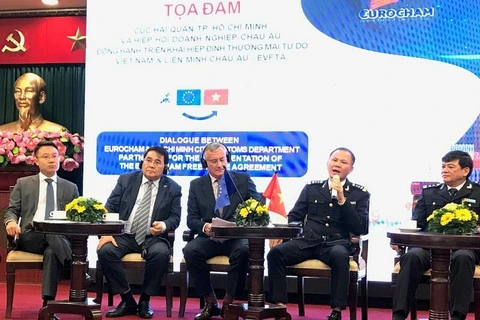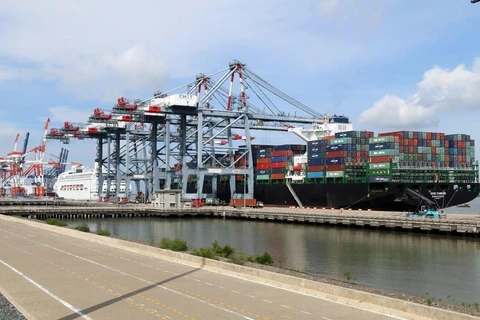 Applying modern technologies in production helps create a breakthrough in labour productivity in the apparel industry (Source: VietnamPlus)
Applying modern technologies in production helps create a breakthrough in labour productivity in the apparel industry (Source: VietnamPlus)
Hanoi (VNA) - The garment-textile sector has gained significant benefits brought about by the EU-Vietnam Free Trade Agreement (EVFTA) as more and more European businesses are investing in the industry.
According to the Vietnam Textile and Apparel Association (VITAS), in the last three years, many EU enterprises have invested in Vietnam's textile and garment materials sector to take advantage of opportunities offered by the EVFTA.
Not only opening up many opportunities, but the free trade pact between Vietnam and the EU will also create an attraction for Vietnam's apparel industry to receive more investment opportunities from European businesses, Chairman of VITAS Vu Duc Giang said at a workshop on August 2.
Key market for garment and textile industry
According to Giang, the sector set to earn 40 billion USD in export turnover this year, in which the US market contributes 42 percent of the value, followed by the EU - 21.5 percent, Japan – 19.5 percent and the Republic of Korea – 14 percent.
Although ranked second, the EU remains a strategic, key and long-term market of Vietnam's garment and textile industry because the inflow of goods to the EU has higher added value than those to other countries, Giang said, adding that the EU is also a traditional and stable market for Vietnamese enterprises.
Besides, European consumers have stricter choices that will be an advantage for Vietnam when exporting high-quality commodities to the market.
Nguyen Thi Thu Trang, Director of the WTO Integration Centre at the Vietnam Chamber of Commerce and Industry (VCCI), highly valued the free trade agreement signed between Vietnam and the EU, because it is not only a big market but also a very attractive market to exporters.
Citing recent research data, Trang said that, in 2018, Vietnam's textile and garment exports to the EU reached 5.6 billion USD, accounting for only 2.02 percent of the union’s imports of the items.
She noted that there is room for Vietnam's apparel industry in the future.
Solving lack of supplies
Luong Hoang Thai, Director General of the Multilateral Trade Policy Department under the Ministry of Industry and Trade, pointed out challenges facing Vietnam's exports when the country joins new generation free trade agreements.
He stressed the need to set up a sustainable supply chain in order to keep foreign enterprises from moving to other countries.
If labour costs rise or the investment environment is not attractive, many investors will surely move to other countries, he said.
Therefore, creating a stable market will help Vietnam invest in and participate deeper in supply chains and also create greater value, Thai said.
Vietnam ranked third in exporting garment and textile products after China and India. To maintain the current position, relevant agencies need to devise strategic plans for developing industrial parks and supplies as well as joining global supply chains so as to meet the terms of the EVFTA, Giang said.
He noted that the agreement will create a great magnet in luring investment.
Furthermore, investment flows from Europe has also helped Vietnam’s apparel industry solve the lack of domestic supplies.
Many enterprises operating in the industry have used solar and renewable energy in their production activities, contributing to protecting the environment, Giang added.
Vietnam’s textiles export value always maintains double-digit growth with increasing value, he said.
The industry reported export earnings of 29.3 billion USD in the first nine months of the year.
Many textlie and garment businesses have set up e-commerce systems deals or invested in their own online sales services to increase domestic market share.
Viet Tien Company has invested in a fashion design centre, while Duc Giang Corporation has focused on building and developing its own brands such as Paul Downer, HeraDG and Forever Young.
Other enterprises such as Nha Be and May 10 are also offering fashionable products in various styles and categories to meet diverse consumption needs, ensuring quality and design to follow international trends./.























